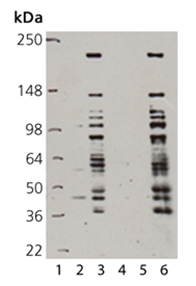Like ubiquitin, the SUMO proteins are protein modifiers that are covalently attached to the epsilon-amino groups of lysine residues within substrates and play an important role in a wide variety of biological processes. The mammalian SUMO family includes at least three members, SUMO-1, SUMO-2 and SUMO-3, and SUMO-4, although the role of the latter remains poorly understood. All members are expressed in precursor form and have to be C-terminally processed to give the functionally active mature forms. In contrast to ubiquitinylation, SUMO conjugation is highly specific in terms of target lysine residues, but many aspects of substrate and lysine selection by the SUMO conjugating machinery still await clarification. SUMOylation events usually occur at a consensus motif, although not all such motifs are modified, demonstrating a need for additional specificity determinants in SUMOylation.
In other cases modification occurs at non-consensus sites. The regulation of SUMOylation is intimately linked to other post-translational modifications, including ubiquitinylation, phosphorylation and acetylation. While target proteins are predominantly conjugated to monomeric SUMO, all three SUMO family members are able to form chains in vitro. In cells, SUMOs have the potential to polymerise via internal consensus sites for SUMOylation that are present in both SUMO-2 and SUMO-3. SUMO chain formation is reversible; SUMO polymers are disassembled by SUMO proteases both in vitro and in vivo. However, the functional relevance of SUMO polymerisation is still unclear and much work focuses on the identity of the endogenous target proteins that are conjugated to SUMO polymers. There is a growing appreciation for the existence of cross-talk mechanisms between the SUMOylation and ubiquitinylation processes. Rather than being strictly parallel, these two systems have many points of intersection, and it is likely that the coordination of these two systems is a critical contributor to the regulation of many fundamental cellular events.











